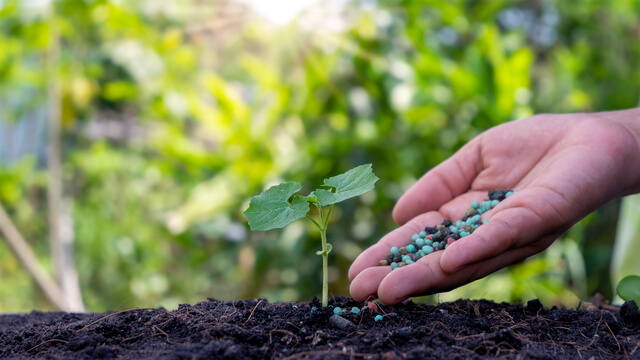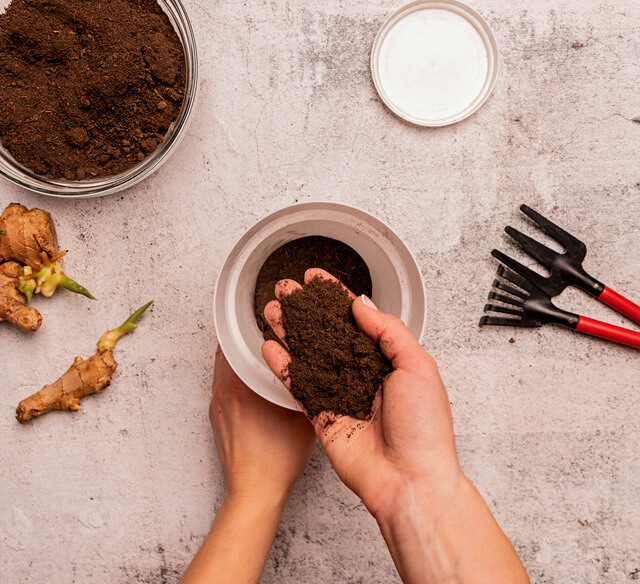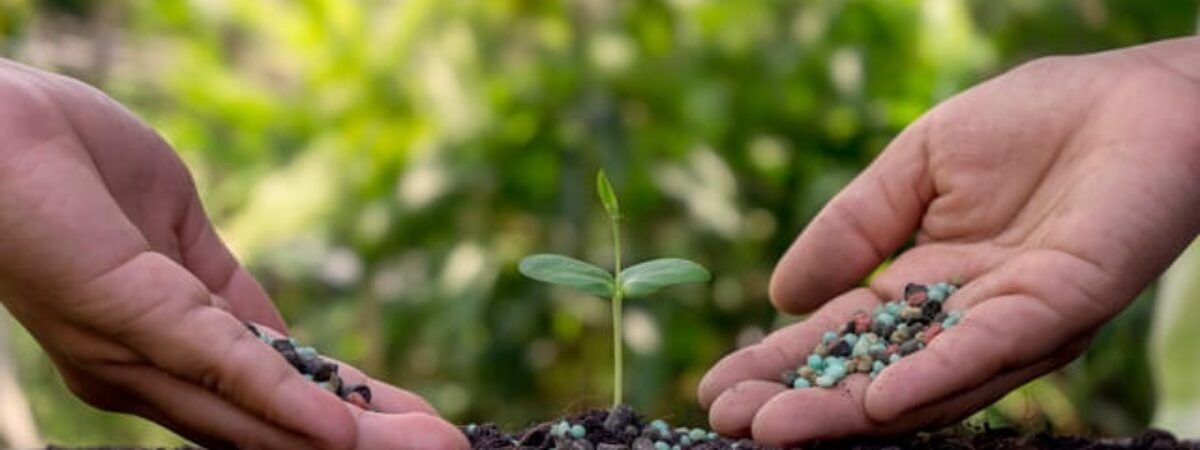We all are aware of the famous saying that a healthy mind resides in a healthy body, so we make sure to take 3 meals a day with a proper balanced diet.
The large molecules are broken down into smaller molecules by our digestive tract and help in the growth and maintenance of our body parts. Basically, the food we eat breaks down into basic building blocks.
Similarly the same process occurs in plants as well. The plants that we grow in the backyard are living things like us and hence need proper nutrition, sunlight, water, air on Earth to survive and grow.
A healthy plant can only be grown in a healthy soil. The only difference between plants and animals is that they lack a digestive system so they need to start with smaller molecules.
Plants absorb light from the Sun, moisture from rainfall, and nutrition from the soil, but it’s not possible for the soil to have all the essential nutrients required by the specific plant. Hence, it is important to feed your plants with the right amount of nutrients and at the right time for their proper growth and development. So it is essential to have a proper idea on fertilizers for vegetables
Nitrogen and phosphorus fertilizers are mostly required by the vegetable garden, but again only this is not enough to get a healthy vegetable garden, obviously, there are more nutrients that have specific functions in plant growth.
So, let’s learn in detail about fertilizer in order to get a clear idea of keeping our vegetable garden healthy and sustainable.

What are plant nutrients?
Plant nutrients are basically the chemical elements that nourish plant health. They mainly fall in three categories and each nutrient has their specific role in providing nutrition.
Essential elements are Carbon, Hydrogen and Oxygen that plants absorb from air. Other nutrients are provided by the soil.
There are major or macronutrients that our vegetable garden requires in large amounts and micronutrients or trace nutrients that our vegetable garden requires in lesser quantities.
However, each and every element plays a significant role and deficiency of even one element can reduce the growth of plants.
Now lets have some brief idea on what specific function does each nutrient has-
The macronutrients are nitrogen, phosphorus, potassium, sulphur, magnesium and calcium. Among these the primary nutrients are Nitrogen, Phosphorus and Potassium that plants take up in a major amount, whereas sulphur, magnesium and calcium fall under Secondary nutrients.
The micronutrients are molybdenum, manganese, boron, zinc, iron, chlorine, copper, nickel, though these are not required in large amounts but deficiency of these elements can lead to many deficiencies.
Let’s have a look on major roles they play-

Nitrogen
It is an essential element that helps in chlorophyll and cell formation, protein synthesis, required for all plant growth processes. But excessive application can decrease immunity and fruit growth. It is mainly beneficial for green leafy vegetables.
Phosphorus
It mainly helps in developing seed, fruit and roots, flower initiation. This is mostly required by young cells i.e shoots and root tips as metabolism is high here.
The best part is it has been shown that in some plants it has reduced disease incidence and enhances the quality of certain crops.
It is a slow moving fertilizer, so it is easily accessible by the plant roots.
Potassium
This is important for plant growth as it acts as an enzyme activator and promotes metabolism. It controls opening and closing of stomata thus helps in water uptake of vegetables.
It helps in resisting diseases and improves seed and grain size thus improving the quality of fruits and vegetables. It can affect the plant’s size, color, taste and shape and hence it is more effective in fruit bearing vegetables.
Calcium
As we need calcium for our bone health, similarly vegetables too need calcium for their cell wall membrane formation and plasticity. It also helps in lowering soil acidity.
Magnesium
It is a major constituent of chlorophyll and mainly helps in translocation of sugars within a plant.
Sulphur
It forms plant proteins, helps in seed production, chlorophyll formation, and stabilizes seed structure.
All other nutrients are though not necessary in the same amounts like the primary macronutrients but their deficiency can impact your vegetable growth and hence are required in trace amounts by the vegetables.
Now you must be thinking how to know the right application of these plant nutrients. So there are various fertilizers, amendments and compost that come up with the combination of these plant nutrients in a particular ratio. They basically act as food for the plants.
These fertilizers are available in certain doses with a healthy balance of nutrition. So, let me give you detailed information on fertilizers and how to apply them to your vegetable garden.
What is fertilizer?
Fertilizers are basically the chemical compounds. These are given to the crops in order to increase crop yield and growth. We can consider fertilizers as food supplements.
Being a gardener you must be aware of the fact that gardening is a continuous process. When you have harvested a vegetable, it must have utilized all the available nutrients present in the soil and these lost nutrients are needed to be replaced for the next plant to grow.
Hence,this is the time when fertilizers play their part of providing required nutrients by replacing the lost nutrient. It helps in healthy growth and development of plants.
So if you are fresher in gardening, then it’s always recommended to do a soil test in autumn to get a clear idea on your soil’s fertility level. It will help you in knowing the right amount and type of fertilizer to be applied.
It’s always best to have an idea on soil’s fertility level, as it helps in deciding the types and quantity of fertilizer. Moreover the plants will uptake only the amount they need, so over use of fertilizers may lead to abnormal growth.
Types of fertilizers
There are basically two types of fertilizers- organic and chemical fertilizers.

Organic fertilizers
The fertilizers that comprise plant derived materials including dead decayed plants to animal manures and agricultural by-products.These are generally slow releasing nutrients and have low quantity of phosphorus and nitrogen. This happens because of their high moisture content that dilutes the nutrients.
As compared to synthetic fertilizers these are a bit costly and do not require frequent application. They don’t leach down and have no adverse effect on soil.
However there are some exceptions, that releases plant nutrients quickly i.e fish emulsion, animal solids and biosolids. This provides a long term benefit to the soil.
Examples are- manures, bone meals, neem cake, oil seed cake, cotton seed etc that are naturally occurring.
Synthetic fertilizers
These are also called inorganic or chemical fertilizers. These are man made products that are manufactured from natural ingredients. However, the nutrients are present in more concentrated form and are generally fast releasing.
They are in water soluble form in order to quickly release the desired nutrients to the plant.
These are cost effective unlike organic fertilizers. They do have some negative impacts on the environment.
However, taking it slow is the key. As compared to synthetic, water-soluble, fast-acting fertilizers, slow-release granular fertilizers deliver nutrients in a safe manner that can be easily digestible by the plants.
Apart from these there are some natural soil amendments that include compost, lime, wood ash, mulch, worm castings etc which increases the nutrient availability for plants. They don’t contain specific NPK amounts.
Now that you have some idea about fertilizer and its types, it’s time to know why your vegetables require fertilizers.

Why do vegetables require fertilizer?
There are ample reasons why your vegetables need fertilizer. Some of the main reasons are-
The soils should be rich in compost mainly consisting of organic matter and plants need fertilizers for their growth and development.
Vegetables in the garden utilize nutrients from the soil as they grow. So supplying the soil with adequate fertilizer helps in maintaining its fertility level. Click To TweetVegetables in the garden utilize nutrients from the soil as they grow. So supplying the soil with adequate fertilizer helps in maintaining its fertility level.
As we water the vegetable maximum nutrients loss occurs by leaching i.e washing away , so fertilizing is necessary to maintain the nutrition balance.
So as a vegetable gardener, the main thing you should focus is to observe your plant in detail and if you are observing any wilting or yellowing symptoms then it’s time to apply nitrogen fertilizer and if overall the plant looks unhealthy it’s time to apply all the three essential macronutrient i.e. nitrogen, phosphorus and potassium.
Different vegetables require different nutrients to grow, for example tomatoes grow well in calcium rich soil.
Hence it is highly necessary to choose the right amount of fertilizer and apply at the right time.
Methods of application of fertilizers
There are mainly four ways of fertilizer application-
Broadcasting
Before making rows, the required quantity of fertilizers are spread over vegetable plants and then mixed with the soil to a depth of 3-4 inches. This is best for especially home gardeners.
Band or row application
This is basically strip application of fertilizers on the side of rows of vegetables before planting. It must be done with utmost precautions in order to avoid roots coming in contact with fertilizer that may damage the plants.
Starter solution
This application process is more suitable for transplants like tomato, eggplant, cabbage and pepper. All you need to do is to dissolve 2 tablespoons of fertilizer in 1 gallon of water, and stir thoroughly. Then use 1 cup of these and let it mix before transplanting.
Side dressing
This is the best method of applying fertilizers that give the most yield from vegetables. This is more helpful if you have sandy soils or in case of heavy rain where most of the nutrients have leached out.
Basically, in this process you must sprinkle the fertilizer along the sides of rows and then water it so that it enters into the soil. Use 1/2 cup garden fertilizer per 10 feet row
How to choose the best fertilizers for a vegetable garden?
There is no thumb rule to know which fertilizer will work best for which vegetable. Different vegetables will have different requirements of nutrients. Similarly, doses of fertilizer vary from vegetables to vegetables and from soil-soil.
Suppose, your garden soil may lack in potassium and other gardener’s soil may lack in nitrogen content .
For example, tomatoes require calcium rich soil, nitrogen is more preferred for green leafy vegetables , phosphorus is more required for root vegetables, potassium is beneficial for fruit bearing vegetables.
So, for your clear understanding, here there is a list of vegetables based on their feeding capacity of fertilizers. They are generally classified as- heavy feeders, moderate feeders and light feeders.
Let’s have a look
Heavy feeders
They need more fertilizer as compared to other vegetables. So you need to apply the fertilizers based on their requirement. Some of the examples are Spinach, Cabbage, Broccoli, Brussel sprouts, Cucumber, Corn,Cantaloupe, kohlrabi, eggplant, Kale, Pepper , Tomatoes etc.
Moderate feeders
These vegetables don’t require much fertilizer, rather they need a well drained soil with proper moisture. So , it’s better to provide them with mulching. They uptake more liquid plant food. Examples are potato, sweet potato, carrot, beets, okra.
Light feeders
If your soil is enriched with compost, then these vegetables don’t require fertilizer, only a starter solution of fertilizer is enough for these vegetables to grow. Examples are- bean, turnip, peas, southern peas, mustard greens, onion, radish, carrot, beet.
There are three numbers shown in a fertilizer bag which shows the percentage availability of Nitrogen, Phosphorus,Potassium i.e. N-P-K. These are always shown in the same sequence. For example 15-30-15 blend that contains 15 pounds of nitrogen, 30 pounds of phosphorus and 15 pounds of potassium. And the rest of the fertilizer consists of other fillers like sand or rice hulls.This is called a complete fertilizer.Some fertilizers also contain micronutrients along with NPK.
So, basically a complete fertilizer is best to use as it contains all the nutrients and if a soil has one nutrient in adequate amount and other two nutrients are lacking, a complete fertilizer wont increase the already present nutrient in the soil rather will add the deficient nutrient to the soil.
As a vegetable gardener, you should always prefer vegetable fertilizers over lawn fertilizers, because lawn fertilizers have more nitrogen content in them and also comprises many other chemicals, so it will hamper your vegetable growth.
So, there is no difference in fertilizing spring and fall gardens, both have the same process. However, if you have fertilized your spring garden then an only half a dose of fertilizer would be enough for your fall garden vegetables to grow.

Right time to fertilize your vegetables
If you are growing annual vegetables, it’s best to fertilize the soil before planting in spring. And if you are growing perennial vegetables, the best time to use fertilizer is before the growth of vegetables in spring starts.
The fertilizers should be mixed into the soil deeper for vegetables. If your vegetables are looking green and healthy then wait a bit more before applying another dose of fertilizer.
Well drained soil with high porosity requires frequent use of fertilizers, applying a balanced fertilizer in 3-4 weeks in a growing season works best.
If your soil is clay then, it’s a boon for you because they require less fertilizer so fertilizing in 4-6 weeks is enough.
Now, if you prefer to grow vegetables in organic soil, then also it needs a little extra fertilizer for proper growth.
But always remember, that too much usage of fertilizer will harm your vegetables. It can basically burn the vegetable plants.
Application of fertilizers to different vegetables
Tomatoes
Before planting- In a 100 sq. ft area add 3 lbs of 5-10-10 fertilizer. Then after planting, when the fruit sets, side-dress 3lbs of 5-10-10 per 100 sq. ft area.
Pumpkins
Before planting add rotted manure and a handful of 5-10-10 in 6-8 inches of soil. And then after planting side dress with 5-10-10 on hills and side roots.
Sweet potatoes
Preplant application of 3 lbs of 5-10-10 in 100 sq.ft row along with fine compost. Then after 3-4 weeks of transplanting add 3lbs of 5-10-10 in 100sq.ft and 5lbs of 5-10-10 in sandy soil.
Spinach
This only requires a mix of compost, manure and 10-10-10 fertilizer. No more fertilization is required.
Potatoes
Mix 1 lb of 5-10-10 in an 8″ trench or hole in a 25-foot row with 2 inches of soil. In the case of a second hill, use one pound of side-dress. Use compost, seaweed, or fish emulsion per 25-foot row, or 5-10-10 per 250 feet.
Broccoli
Pre-plant application of 3-4 pounds of 5-10-10 in 100 sq. ft. Then apply in side-dress after 3 weeks of transplanting with 1 tonnes of high nitrogen fertilizer.
Brussel sprouts
Before planting apply 2-4 pounds of 5-10-10 in 100 sq. ft area. Then side-dressing once a month with 1-2 tonnes of 5-10-10 per plant.
Organic fertilizers for vegetables
As mentioned earlier, organic fertilizers are chemical free and do not harm the environment, so if you are an eco conscious gardener then using organic fertilizer is a great option. Though these are slow releasing, they have a long term effect on your soil health.
These are derived from organic sources, including compost, manure, fish emulsion, neem cakes etc.
So let me tell you some organic fertilizer for vegetables-
Blood meal
Prepared from the dried blood of the animals, this fertilizer is beneficial for vegetables as it provides more nitrogen. Mix the blood meal with compost before planting the vegetables in the spring season and then continue adding it throughout the growing season. This is best for nitrogen lovers like sweet corn, pepper, greens, cucumber.
Fish emulsion
This is a byproduct of fish like bones,scales or skin. This is basically high in nitrogen content and helps the growth of plants in summer.
Bone meal
This fertilizer has more nitrogen and phosphorus content. It helps in bulb and root development. To get the best results, it can be combined with a blood meal.
Neem cake
It is a natural pesticide and enhances soil fertility. It helps in balancing soil alkalinity.
Rock phosphate
Also known as rock dust, these can add minerals to the deficient soil and can give richer taste to your vegetables. It increases root growth and yield as well.
Adding organic fertilizers doesn’t mean that you don’t need any chemical fertilizers. Chemical fertilizers have high nutrient content. So definitely your vegetables will require them. Moreover organic fertilizers are a bit costlier and required in bulk.
However, organic fertilizers can boost your overall soil health.
Apart from these, using cover crops and mulch are also helpful in retaining soil moisture and holding nutrients. They give little extra nutrients to the plant.
Mulching helps in keeping the weeds at bay and reduces excess runoff.Some examples of mulch are Hay, grass clippings, straw, newspaper, dead leaves.
Cover crops help in boosting soil microbes for nearby plants and overall soil health.
Conclusion
Probably, now you must have got a clear idea on nutrients, fertilizers and their benefits to vegetables. Your vegetables need proper care and nutrition to grow properly .
So, what are you waiting for? Start taking care of your vegetables and supply them with adequate nutrients that they need so that you can get best results in return.
You may also like to read
9 Best Mushroom Growing Kits You Must Buy in 2022
List of Cruciferous Vegetables – 15 Popular Green Crops to Grow at Home







One thought on “Fertilizers for Vegetable Garden – A Complete Guide”